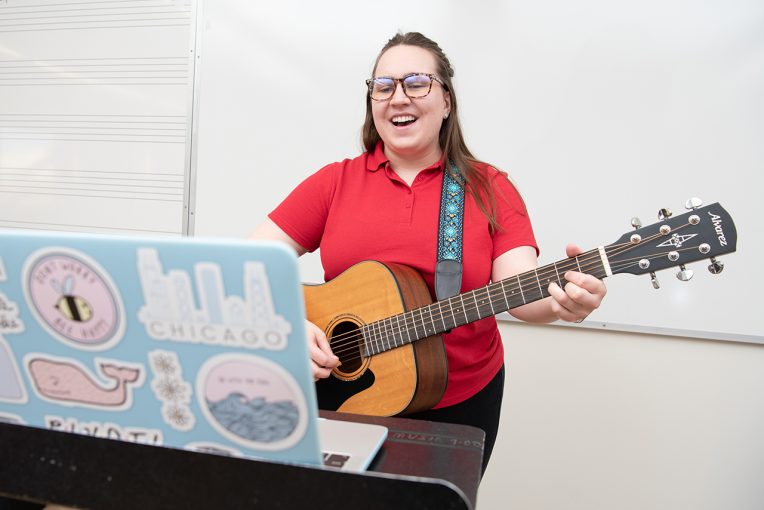Face-to-face interactions bring joy to both music therapy students and their clients. Although Illinois State students are now completing their clinical hours through telehealth sessions, they have continued to deliver compassionate care.
“Clients are benefitting from the connection and social engagement,” said Emily Beinborn ’10, M.M. ’13, coordinator of the music therapy program’s clinical training. “The sessions are providing joy and quality of life. We have seen many positive outcomes both for the students and clients.”
Music therapy is the clinical use of music to help individuals within a therapeutic relationship. Students work with clients of all ages and abilities.
This semester, there are 18 music therapy students in practicum—the hands-on application of their studies. They serve clients from seven sites, including nursing homes, mental health counseling facilities, and hospices. Beinborn and her colleague Megan Hildebrandt find the sites, which has been a new challenge since the coronavirus (COVID-19) pandemic forced the program to the telehealth format last spring.
“This semester presented some additional challenges,” said Beinborn. “We had to make sure that we had facilities that had the resources and technology available in order to connect our students with clients.”

The students connect with their clients through private Zoom meetings. Student Taylor Stengren conducts her sessions from a classroom in Centennial West.
“I’ll get myself on campus, set up my computer, and bring all my instruments that I need,” said Stengren, a second-year graduate student from Fox River Grove. “We’ll start the session off by making sure that things are going smoothly and the client is doing well. We’ll usually start with our opening song. We go through all the applications each session, and then I’ll end the session with our closing song.”
Opening songs serve as a greeting to get the client warmed up, while closing songs are used to reflect on the session and prepare for next time. Students implement as many as eight applications throughout the session, such as songwriting, call-and-response, and instrument play. While students would normally bring their own instruments to an in-person session, they have had to work with their clients’ sites to create instruments.
“Our students have become very creative in helping clients to create their own DIY instruments to make music,” said Beinborn. “I have seen plastic storage containers filled with rice or beans to substitute shaker instruments. Some clients are using tabletops, buckets, or pots and pans for drums. Some students are leading clients in body percussion.”
Lauren Siemer often conducts her telehealth sessions from her home. Despite the technical difficulties that can arise, she has enjoyed the convenience of telehealth.
“It’s amazing that you can do it from anywhere,” said Siemer, a senior from Teutopolis. “If I’m at school, I can lead online. If I have to go home that week, I can just lead from home. In the past, I’ve had 40-minute drives to a session. For this, I can just log on and be right there.”
While this semester has brought unprecedented challenges to music therapy students and faculty, they have risen to the occasion. Being open-minded and patient have been key.
“It’s still a really fulfilling experience,” said Siemer. “It’s important not to brush it under the rug just because it’s not what you’re used to.”
It also helps that the students and faculty are deeply passionate about what they do. Siemer was first inspired to pursue music therapy after watching her older brother receive music therapy.
“My older brother had leukemia from when I was in sixth grade until I was in high school,” said Siemer. “He had a music therapist, and that inspired me to check it out and see what it was all about. I decided it was for me.”
Stengren was interested in the concept of music therapy, but she did not know that it was a field of study until one of her undergraduate professors mentioned it. Her undergraduate college did not offer a music therapy major, so she double majored in music education and psychology before coming to Illinois State for graduate school.
“I took a gap year and then came to ISU,” said Stengren. “I fell in love with the professors and their mindsets with music therapy, so that’s what brought me here.”
The telehealth experience has set up the students for success. “Students are learning how to adapt and be flexible, and I have found them to be very resilient,” said Beinborn. “Telehealth sessions are continuing to provide them with experiences to expand their music, therapeutic, and clinical skills, and they are building connections with the individuals they see.”
Apply now for fall 2021.

